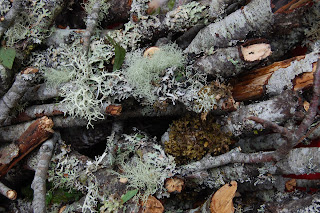"Snap, Crackle, POP POP POP!" - It began with an explosion of noise I had never heard before. I ran outside to see - was it elk going crazy? Where there a gang of rural hoodlums loose in our forest with firecrackers? POP! POP! CRRRRRRRRASSSSSH.
When a tree falls in a forest, it sure as hell makes a sound!
The common trees of the Olympic National Forest are Douglas-fir, Western hemlock, Western redcedar, Grand fir, and Sitka spruce. These old forest trees are 30 stories tall and older than 200 years.
The trees on Maple Creek are all at least 100 feet tall and there are a number of snags, or, standing dead trees, around here. Snags are essential to forest life providing birds and mammals with shelter, nesting, and food.
Standing dead trees can remain that way for many years, for many decades even, before they ever fall. These dead trees are integral to the natural diversity of the forest ecosystem, again providing shelter for animals, giving rich nutrient base to new plantlife, and by returning nutrients to the forest floor.
The first week of fall brought a small storm, and pop, one incredibly tall snag fell over right next to our house. (Luckily, not on it!) Our neighbors came over to make sure that we were okay and to offer us a chainsaw along with lots of chitchat.
Joseph went out with the saw and cut up parts of the tree for firewood for the winter. (Good timing!) First, he sections off usable lumber, and what's not usable for lumber he cuts for firewood, and what's not good for firewood he leaves as forest food.
The top of the tree provided us with a great amount of kindling.
Joseph and Danny put in many hours on the chopping block.
We are going to have a warm winter here, come what may.
BONUS PICS: The chickens all followed me out when I was taking pics of the tree. Here ya go!
Wednesday, September 22, 2010
Monday, September 20, 2010
Chanterelle, My Belle
The Pacific Golden Chanterelle is an exquisite Northern fungus. For those whose familiarity with mushrooms begin and end with "Hold the mushrooms please" while ordering Chinese takeout, let's start with basic pronunciation: shahn-tuh-rehl.
These ruffly trumpets grow in abundance up here underneath the Douglas Firs from late summer until it starts to frost. They seem to really blossom when there is sunshine after a good rain.
These beauties have ruffled, wavy edges, with a smooth yellowish coloring. They are meaty with a faint apricot smell.
Check out these gill like ridges.
The mushroom hunt: Joseph says "It's so much fun. You are just running through the woods looking for golden trumpets!" He's had great luck where the moss and the fir meet, finding mushrooms on parallel levels to one another. If you plan on going out on a fungus hunt, go with someone who knows what they are doing. Mushrooms are peculiar and mysterious. And you definitely don't want to come back home with a pound of poisonous mushrooms!
Chanterelles are pretty incredible just sauteed alone in butter. So far we've done them up with pasta, and we also made some amazing omelette's with eggs from our chickens and farm fresh red, orange, yellow and green tomatoes sprinkled on top. Yummies!
If you are interested in learning more about mycology an amazing book to check out is Mushrooms Demystified. Happy Autumn Hunting ya'll!
These ruffly trumpets grow in abundance up here underneath the Douglas Firs from late summer until it starts to frost. They seem to really blossom when there is sunshine after a good rain.
These beauties have ruffled, wavy edges, with a smooth yellowish coloring. They are meaty with a faint apricot smell.
Check out these gill like ridges.
The mushroom hunt: Joseph says "It's so much fun. You are just running through the woods looking for golden trumpets!" He's had great luck where the moss and the fir meet, finding mushrooms on parallel levels to one another. If you plan on going out on a fungus hunt, go with someone who knows what they are doing. Mushrooms are peculiar and mysterious. And you definitely don't want to come back home with a pound of poisonous mushrooms!
Chanterelles are pretty incredible just sauteed alone in butter. So far we've done them up with pasta, and we also made some amazing omelette's with eggs from our chickens and farm fresh red, orange, yellow and green tomatoes sprinkled on top. Yummies!
If you are interested in learning more about mycology an amazing book to check out is Mushrooms Demystified. Happy Autumn Hunting ya'll!
Subscribe to:
Comments (Atom)


















